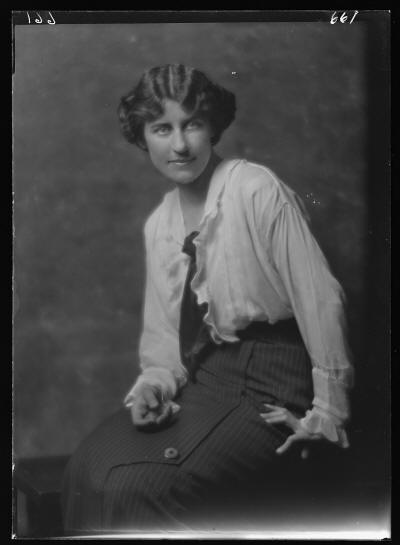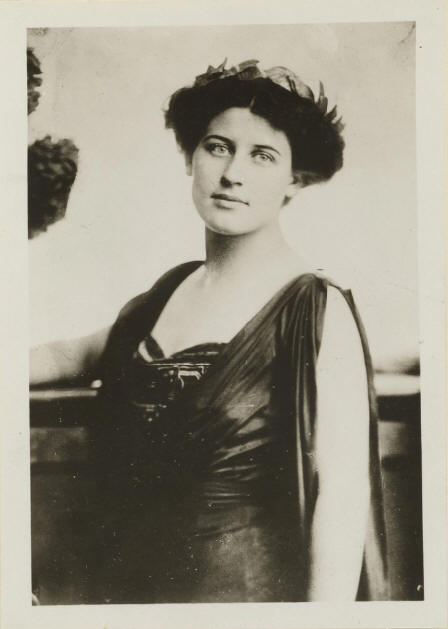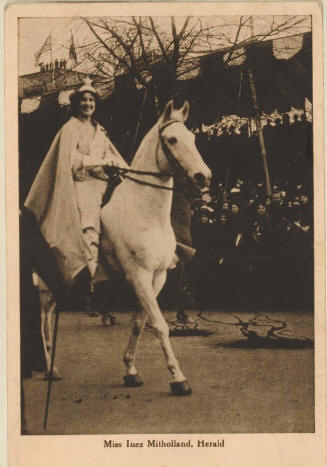Queer Places:
9 E 9th St, New York, NY 10003
Meadowmount School of Music, 1424 County Rte 10, Westport, NY 12993
Vassar College (Seven Sisters), 124 Raymond Ave, Poughkeepsie, NY 12604
New York University, 22 Washington Square North, New York, NY 10011
247 5th Ave, New York, NY 10016
Lewis Cemetery
Lewis, Essex County, New York, USA
 Inez
Milholland Boissevain (August 6, 1886 – November 25, 1916) was a suffragist,
labor lawyer, socialist,[1]
World War I correspondent, and public speaker who greatly influenced the
women's movement in America. She was active in the National Woman's Party and
a key participant in the 1913 Woman Suffrage Procession. She was a member of the
Heterodoxy Club.
Inez
Milholland Boissevain (August 6, 1886 – November 25, 1916) was a suffragist,
labor lawyer, socialist,[1]
World War I correspondent, and public speaker who greatly influenced the
women's movement in America. She was active in the National Woman's Party and
a key participant in the 1913 Woman Suffrage Procession. She was a member of the
Heterodoxy Club.
Born and raised in Brooklyn, New York, Inez Milholland grew up in a wealthy
family. Known as Nan,[2]
she was the eldest daughter of John Elmer and Jean (Torrey) Milholland and had
one sister,
Vida, and one brother, John (Jack). Her father was a New York Tribune
reporter and editorial writer who eventually headed a pneumatic tubes business
that afforded his family a privileged life in both New York and London. In
London she met and was impressed by the English suffragette
Emmeline Pankhurst.[2]
Milholland spent summers on her family's land in Lewis, Essex County, New
York; the property is now the Meadowmount School of Music. Her father
supported many reforms, among them world peace, civil rights, and women's
suffrage. Her mother exposed her children to cultural and intellectual
stimulation.[3]
Inez Milholland received her early education at the Comstock School in New
York and Kensington Secondary School in London. After finishing school, she
decided to attend Vassar but when the college wouldn't accept her graduation
certificate she attended Willard School for Girls in Berlin.[4]
During her attendance at
Vassar College she was once suspended for organizing a women's rights
meeting. The president of Vassar had forbidden suffrage meetings, but
Milholland and others held regular "classes" on the issue, along with large
protests and petitions. As a student she was known as an active radical.
Defying the campus suffrage meeting ban, she convened one in a cemetery across
the road.[2]
She started the suffrage movement at Vassar, enrolled two-thirds of the
students, and taught them the principles of socialism. Milholland was
president of the campus Intercollegiate Socialist Society, which was dominated
by women at the time and reflected their identification with the oppressed.[5]
For Milholland, socialism was "a vital means to correct the monster evils
under the sun."[6]

by Arnold Genthe


With the radical group she had gathered about her, she attended socialist
meetings in
Poughkeepsie which were under the ban of the faculty.[7]
An athletic young woman, she was the captain of the hockey team and a member
of the 1909 track team; she also set a record in the basketball throw.
Milholland was also involved in student productions, the Current Topics Club,
the German Club, and the debating team.[4]
After graduating from Vassar in 1909, she tried for admission at
Yale University,
Harvard University, and
Cambridge University with the purpose of studying law, but was denied due
to gender. Milholland was finally matriculated at the
New York University School of Law, from which she took her LL.B. degree in
1912.[8][9]
Milholland's causes were far reaching. She was not only interested in
prison reform, but also sought world peace and worked for equality for African
Americans. Milholland was a member of the
NAACP, the
Women's Trade Union League, the Equality League of Self Supporting Women
in New York (Women's Political Union), the
National Child Labor Committee, and England's Fabian Society.[10]
She was also involved in the
National American Woman Suffrage Association, which later branched into
the grassroots radical
National Woman's Party. She
was one of the principal members of the Congressional Union
for Women Suffrage (CUWS) alongside Olympia Brown,
Mabel
Vernon, Crystal
Eastman, Lucy Burns, and Alice
Paul.
Milholland was later admitted to the bar and joined the New York law firm
of Osborne, Lamb, and Garvan, handling criminal and divorce cases. In one of
her first assignments, she had to investigate conditions at
Sing Sing
prison. At the time female contact with male prisoners was frowned upon, but
she insisted on talking personally with the prisoners to uncover the horrible
conditions.[10]
Additionally, she wanted to see what it felt like to be an inmate, so she had
herself handcuffed to one.[11]
Milholland stepped into her first suffrage parade on May 7, 1911. She held
a sign that read, "Forward, out of error,/Leave behind the night,/Forward
through the darkness,/Forward into light!" Milholland quickly became the face
of the suffrage movement. The New York Sun stated that "No suffrage
parade was complete without Inez Milholland." Suffrage leader
Harriet Eaton Stanton Blatch had Inez lead parades
[2]
in 1911, 1912, and 1913.[12]
On March 3, 1913, the day before
President Woodrow Wilson's inauguration, Milholland, 27, made her most
memorable appearance, at the
Woman Suffrage Procession in Washington D.C. which she had helped
organize. Suffrage leader
Alice
Paul placed her at the head of the parade[2]
wearing a crown and a long white cape riding a large white horse named "Gray
Dawn."[10]
Horses became a very common method of spreading information about the suffrage
movement and other suffragists such as
Claiborne Catlin Elliman rode horses to raise awareness for the movement.[13]
Milholland believed that women should have the right to vote because of the
traits that were unique to women. She argued that women would metaphorically
become the "house-cleaners of the nation." She believed women's votes could
remove social ills such as
sweatshops,
tenements,
prostitution,
hunger,
poverty,
and
child mortality. She told men that they should not worry about the women
in their lives as they were extending their sacred rights and duties to the
whole country rather than inside the home. Even though she spoke of these
issues, she was always disappointed that she was better known for her looks
than her brains.[14]
Milholland traveled overseas to Italy at the beginning of
World
War I shortly after the
RMS Lusitania had been torpedoed by a German U-boat. After landing,
the captain informed Milholland that a German submarine followed them across
the ocean. With this information, she began writing for the
Tribune and became a war correspondent. Milholland worked to be
allowed to visit the front lines in the war as she continued to write anti-war
articles that led to her censure by the Italian government, which ousted her
from the country.[15]
Upon returning from Italy they moved to 247 Fifth Avenue, NYC. Milholland suffered from bouts of depression.
She felt that she had been barred from the front because she was a woman and
not because she was a pacifist. She felt like she had returned a failure.[16]
She was also a leading figure on
Henry
Ford's ill-fated
Peace
Ship expedition of late 1915, steaming across the Atlantic with a team of
pacifist campaigners who hoped to give impetus to a negotiated settlement to
the First
World War. However, she left the ship in Stockholm because the trip was
unorganized and dissension had ensued between passengers.[10]
Inez Milholland became the classic
New Woman
in the beginning of the 20th century. She loved the new dance crazes of the
Turkey Trot and the
Grizzly Bear and enjoyed traveling to Paris and buying Parisian couture
gowns. Additionally, her views mirrored those of the New Woman when it came to
sexual love.[17]
By the fall of 1909, Inez Milholland and
Max
Eastman became rising radical stars due to their handsome looks. Inez knew
Max through his sister,
Crystal Eastman whom she met at socialist and suffrage rallies. Inez told
Max that she loved him and tried to convince him to elope with her. When he
finally reciprocated her love and agreed to marry her, their relationship fell
apart. They both realized they could not be lovers, but they did remain close
lifelong friends.[18]
Max and Crystal Eastman lived together for several years on 11th Street in
Greenwich Village among other radical activists.[4]
The group, including
Ida Rauh,
Inez Milholland,
Floyd
Dell, and
Doris Stevens, also spent summers and weekends in
Croton-on-Hudson.[5]
In the same way that she fell fast in love with Eastman, soon after she
began seeing the author
John Fox, Jr.. She told him she loved him but he didn't reciprocate right
away. When he did tell her that he loved her, she was no longer interested.[19]
In July, 1913 while on a cruise to London, Milholland proposed to
Eugen Jan Boissevain, a Dutchman she had known for about a month. The two
were married on July 14 at the Kensington registry office which was as soon as
they could after their arrival in London without consulting their families.
John Milholland was in New York at the time and heard about the marriage from
the press. John insisted that the two get remarried in a church, but Inez
refused.[20]
The marriage between Milholland and Boissevain was not perfect. A
complication arose when the couple returned to New York from London.
Milholland was no longer an American citizen because the
Expatriation Act of 1907 provided that if an American woman married a
non-American, she took her husband's nationality. Although married, Milholland
did not stop flirting with other men and often wrote to Boissevain to tell
him. Additionally, most disappointing to the couple was the fact that they did
not have any children.[21]
In 1916, she went on a tour in the West, speaking for women's rights as a
member of the
National Woman's Party. She undertook the tour despite suffering from
pernicious anemia and despite the admonitions of her family, who were
concerned about her deteriorating health. On October 22, 1916, she collapsed
in the middle of a speech in Los Angeles, California, at Blanchard Hall and
was rushed to
Good Samaritan Hospital. Despite repeated blood transfusions, she died on
November 25, 1916.[22]
Milholland's last public words were, "Mr. President, how long must women
wait for liberty?"[23]
After she died, her sister
Vida Millholland devoted her time to suffrage work including going to
prison for three days in 1917.[24]
Dora Lewis was arrested in August
1918 at the Lafayette Square meeting in honor of Milholland (where she was the
primary speaker) and sentenced to 15 days.
In a tribute to Inez Milholland, it was proposed to rename Mount Discovery
in the Adirondacks for her, however the name change was never officially made.[4]

Edna with Arthur Ficke and
Inez Millholland
Carl Sandburg wrote a poem about Inez Milholland titled "Repetitions,"
which appears in his 1918 volume, Cornhuskers.[25]
Edna St. Vincent Millay, who married Milholland's widower Eugen Boissevain
in 1923,[26]
also wrote a poem, "To Inez Milholland," included in her collection The
Buck in the Snow.[27]
Julia Ormond portrayed Inez Milholland in the movie
Iron Jawed Angels.[28]
The Inez Milholland Professorship of Civil Liberties at
New York University School of Law, filled by
Burt Neuborne, was named in her honor.[29]
My published books:


BACK TO HOME PAGE

- https://en.wikipedia.org/wiki/Inez_Milholland
 Inez
Milholland Boissevain (August 6, 1886 – November 25, 1916) was a suffragist,
labor lawyer, socialist,[1]
World War I correspondent, and public speaker who greatly influenced the
women's movement in America. She was active in the National Woman's Party and
a key participant in the 1913 Woman Suffrage Procession. She was a member of the
Heterodoxy Club.
Inez
Milholland Boissevain (August 6, 1886 – November 25, 1916) was a suffragist,
labor lawyer, socialist,[1]
World War I correspondent, and public speaker who greatly influenced the
women's movement in America. She was active in the National Woman's Party and
a key participant in the 1913 Woman Suffrage Procession. She was a member of the
Heterodoxy Club.




